Xylophanes pyrrhus
Xylophanes pyrrhus
zail-AH-fan-eesMPEER-rus
Rothschild & Jordan, 1906
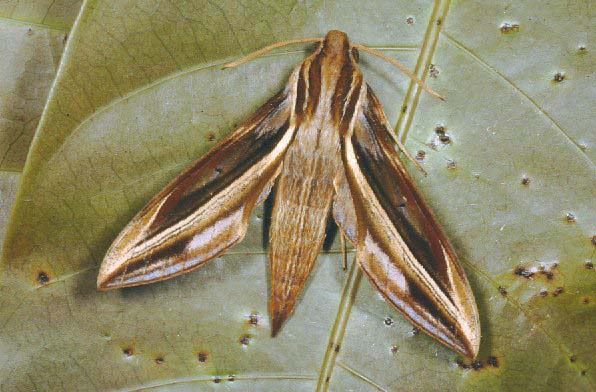
Xylophanes pyrrhus courtesy of Paolo Mazzei,
Rancho Grande, H. Pittier National Park, Venezuela.
This site has been created by
Bill Oehlke at oehlkew@islandtelecom.com
Comments, suggestions and/or additional information are welcomed by Bill.
TAXONOMY:
Family: Sphingidae, Latreille, 1802
Subfamily: Macroglossinae, Harris, 1839
Tribe: Macroglossini, Harris, 1839
Genus: Xylophanes Hubner [1819] ...........
Species: pyrrhus Rothschild & Jordan, 1906
|
MIDI MUSIC
.....It's a Wonderful World.....
copyright C. Odenkirk
ON.OFF
<bgsound src="world.mid" LOOP=FOREVER>
|
DISTRIBUTION:
Xylophanes pyrrhus (forewing length = 33-37mm)
fly from
Venezuela: Aragua, Barinas, Lara, Merida;
Ecuador: Pichincha; to
Peru: Madre de Dios (1500m) (pbj); Carabaya (CATE); (Peru is given as the specimen type
locality) and further south to
Bolivia:
La Paz: Caupolican, El Pinalito;
Murillo, Río Zongo, (750m);
Cochabamba: (80m).
I suspect this species would also be present in Colombia, but I have no confirmed reports (now confirmed by Janet Zinn).
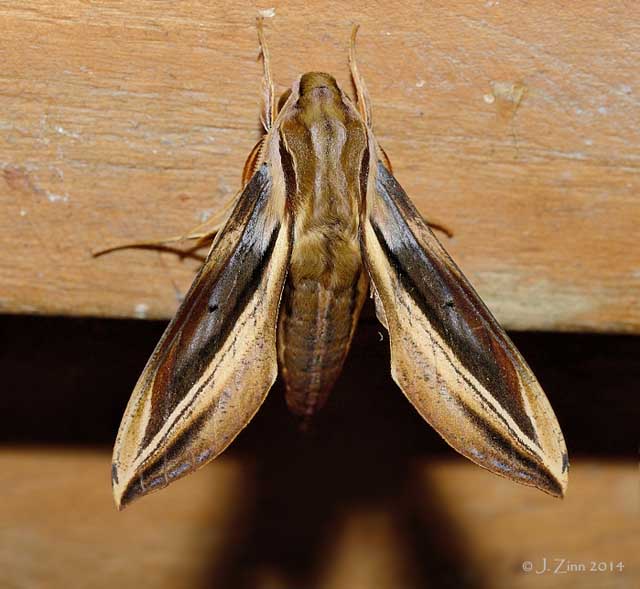
Xylophanes pyrrhus, El Dorado, Santa Marta Mountains, Guarjira, Colombia,
February 19, 2014, courtesy/copyright of Janet Zinn, id by Bill Oehlke.
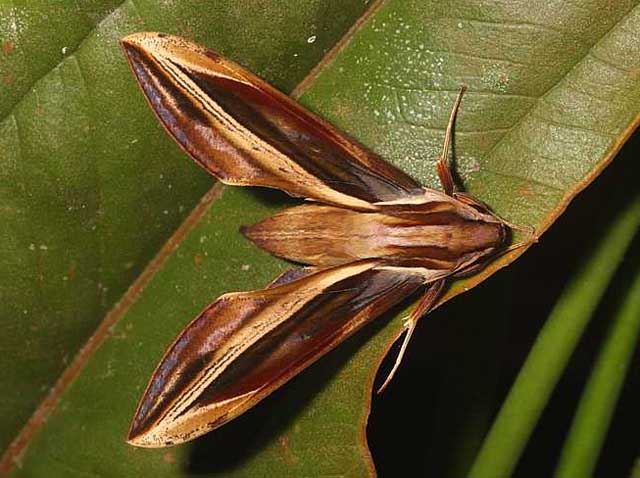
Xylophanes pyrrhus, San Pedro, Madre de Dios, Peru,
September 17, 2008, 1500m, courtesy of Peter Bruce-Jones.
CATE Sphingidae indicates this species is similar to Xylophanes thyelia thyelia.
However, X. pyrrhus is much larger, and its
forewing apex is slightly more elongate and falcate.
The forewing discal spot is smaller in pyrrhus, and the third and fourth postmedian lines are very narrow and close, but never fused.
These lines continue below M3 as a pair of more diffuse but essentially continuous lines. The fifth postmedian line continues below M3 to the inner margin as a
narrower and diffuse line. In thyelia this fifth line is very weak, almost non-existent in its lower half.
Rs4, basal to second postmedian line, is highlighted with buff over its entire length.
The forewing underside is also similar to that of Xylophanes thyelia thyelia, but the most basal of the three dark brown postmedian lines is further from the
middle line than that line is from the most distal line, and is slightly divergent from the other two apically.
I also find that the brown subterminal line in pyrrhus continues from the apex to the inner margin, broadening and becoming slightly more diffuse
in its lower half. The same line in thyelia disappears as it approaches the inner margin, providing for a relatively large, uniform tan area near the forewing anal angle.
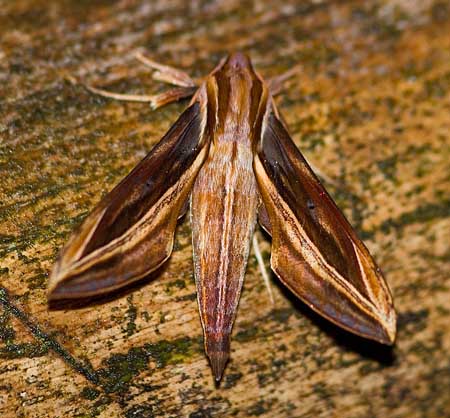
Xylophanes pyrrhus,
Bella Vista Lodge, Pichincha, Ecuador,
October 19, 2009, courtesy of Leif Gabrielsen.
The pronunciation of scientific names is
troublesome for many. The "suggestion" at the top of the page is
merely a suggestion. It is based on commonly
accepted English pronunciation of Greek names and/or some
fairly well accepted "rules" for latinized scientific names.
The suggested pronunciations, on this page and on other pages,
are primarily put forward to assist those who hear with internal
ears as they read.
There are many collectors from different countries whose
intonations and accents would be different.
Jean Marie Cadiou writes, "When I say "Xylophanes" in English I
pronounce it something like "Zailophanees", with the emphasis on the
"o". The French pronounce it differently, something like
"Kzeelophaness" with no emphasis, and the Germans yet in a
different way..."
Some of the early describers/namers chose genus
and species names indicating some character of the insect, but more
often, they simply chose names from Greek or Roman mythology or
history.Those species names which end in "ensis" indicate a
specimen locale, and those which end in "i", pronounced "eye", honour
a contempory friend/collector/etc.
"Xylophanes" sounds like it is from Greek mythology,
and Pyrrhus, the King of Epirus, was a military leader who defeated
the Romans at Heraclea (280) and Asculum (279) despite his own
staggering losses.
FLIGHT TIMES:
Xylophanes pyrrhus adults fly
in August in Bolivia. Peter Bruce-Jones reports a September flight in Madre de Dios, Peru,
at elevations of 1500m. Janet Zinn reports a February flight in Colombia.
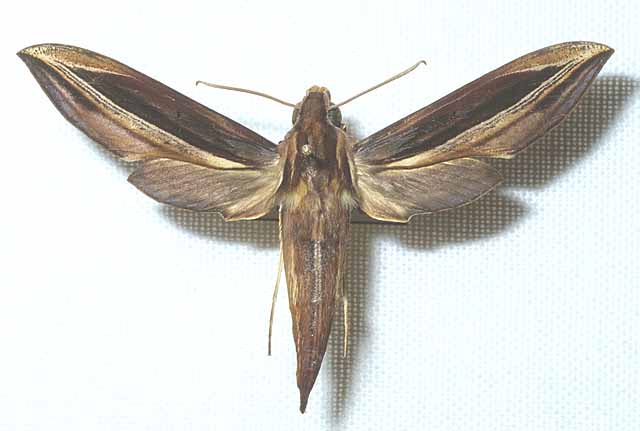
Xylophanes pyrrhus male, courtesy of
Hubert Mayer
copyright.
ECLOSION:
Pupae probably wiggle to surface from subterranean chambers or leaf litter just prior to
eclosion.
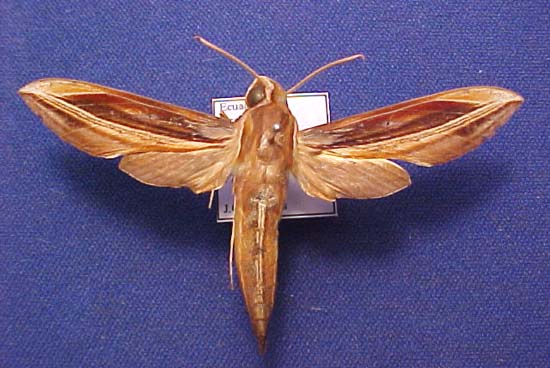
Xylophanes pyrrhus by John Vriesi.
SCENTING AND MATING:Females call in the males with a pheromone released from a gland at the tip of the
abdomen. Males come in to lights very readily, but females are seldom taken in that way.
EGGS, LARVAE, PUPAE:
The snake-like larva has a head and the three thoracic segments which may be retracted
into abdominal segment 1, which is swollen and adorned with a pair of light-ringed grey eye-spots.
Use your browser "Back" button to return to the previous page.
Goto Main Sphingidae Index
Goto Macroglossini Tribe
Goto Central American Indices
Goto Carribean Islands
Goto South American Indices
Goto U.S.A. tables





